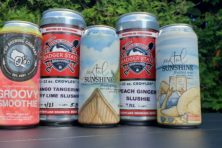Suds with Sophie: The Beers America Loves Best
- Share
- Tweet
- Pin
- Share
Although craft brewing continues to grow through a variety of new breweries, beer styles, ingredients and experimentations, there’s no denying a simple truth: This nation loves IPAs. There are so many bits and pieces to cover about IPAs, and because we’re gearing up to celebrate the Fourth of July, I figured this would be a great time to talk about American-grown hop varieties.
To start off, hops are a terroir product. You may be familiar with this term as it relates to wine, but it definitely applies to hops as well. It means that when certain famous European hop varieties such as German Hallertau or English Fuggles are grown in the U.S. – or in any region other than their own – the hop is given a different name. This is because – as with grapes and other agricultural products – the soil and climate play a big role in the flavor components of the hops.
The IPA craze grew out of California, Oregon and Washington state in a style that’s now referred to as a West Coast IPA. These beers feature a clear (not hazy) appearance, a big hop aroma and a high level of bitterness. Considering that America’s two largest hop-growing regions are in Washington state’s Yakima Valley and Oregon’s Willamette Valley, it’s not surprising that so many highly hopped beers came from this area.
The main hops that came from these regions – Chinook, Cascade, Columbus and Centennial – became so prevalent in these West Coast-style IPAs that they’re now called the “4 Cs.” Their flavor components have defined the American hop profile courtesy of their upfront bitterness and pine and grapefruit flavors.
Although many people believe that all IPAs are highly bittered with pine and grapefruit, other hop varieties have spread, and the range of IPAs has grown exponentially. In fact, few beers now contain these four hops, and even fewer use them exclusively or in high concentrations anymore.
East Coast or New England IPAs – the antithesis of West Coast IPAs – use hops with less bitterness, more citrus and fruit flavors, and high-protein grains such as oats to add a hazy and softer body than their West Coast friends. Although these seem like polar opposites, many beers combine some aspects of both, so hazy beers are not always fruity, and clear IPAs are not always bitter.
The U.S. is one of the world’s largest hop producers, and it produces an incredibly wide variety of flavors and intensities. Some of my favorite hops are Mosaic, Azacca and Citra. They have more berry and citrus notes, with less bittering uses. Mosaic hops feature some tropical and berry notes; Azacca has pineapple flavors; and Citra is – as you’d expect – citrusy.
Locally, you can find lots of beers with only American hop varieties, and I think they’re an excellent way to celebrate Independence Day.
At Door County Brewing Co., the hazy IPA called Bare Bottom Madness features Mosaic, El Dorado and Idaho 7 hops, which provide citrus and berry, tropical fruit and bitterness, and piney floral notes, among others, respectively. The bitterness on this one is kept to a minimum with lots of hazy, full body.
Another all-American favorite of mine, from Door County Brewing’s sister brewery, Hacienda, is It Just Does Weird Things. This hazy IPA uses Citra, our citrus friend; Mosaic, my fruity love; and El Dorado for light, tropical-fruit bitterness. This beer is super citrusy and juicy, with just enough bitterness to balance the sweet flavors.
Bridge Up Brewing in Sturgeon Bay brews Escarpment Pale Ale with only Citra hops. And to clarify: Although Citra’s main flavor note is citrus, like all hops, that doesn’t mean that’s the only flavor you’ll find. Citra also has what are called “catty” notes, or light ammonia flavors. That sounds weird, but it can actually do some very cool things for IPAs when brewed correctly, and I assure you, this beer is brewed correctly!
Now celebrate July Fourth in style: Go grab yourself some American-hopped IPAs!

